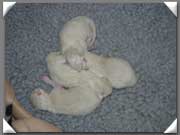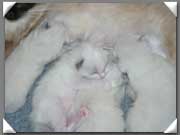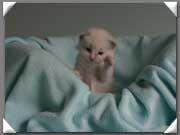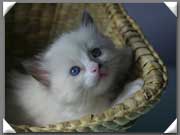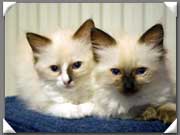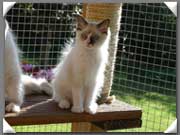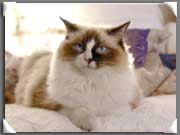


 |
 |
||||
The Ragdoll cat is a delightful breed with a gentle, loving nature. They have a muscular build and are said to be the largest of all domesticated cats with neutered males sometimes weighing up to 20lbs. All Ragdolls are colourpointed, so their face, ears, tail and legs are darker in colour than the rest of the body. They are born completely white or cream in colour and the points begin to develop just a few days after birth. Ragdolls are slow to mature and they do not reach their full size or obtain their final coat quality and depth of colouration, until they are about four years old. When mature, Ragdolls have thick, silky, semi-longhaired coats with a neck ruff and knickerbockers on their hind legs. Their large, oval eyes are always blue and for the purposes of showing, the deeper the colour, the better. Selection of photos showing the development of one kitten (Seal Bi-Colour) from birth to 9 months. The History of the Ragdoll CatThere has been much debate and some mystery surrounding the beginnings of the Ragdoll breed. However it is generally accepted that Ragdolls originated in the USA in 1963, with a litter of kittens born to Josephine, a white angora type cat, who had been mated by two males, a Birman and a Burmese. The resulting offspring were large and extremely docile. Anne Baker used these kittens as the foundation for her breeding programme, which produced the Ragdoll cat we are familiar with today. The breed first came to Britain in March 1981 when Pat Brownsell and the late Lulu Rowley each imported a pair of Blossom Time Ragdolls. The first Ragdoll kittens to be bred in Britain were born in quarantine to Blossom Time Lass and Lad. By 1982, Lulu, who bred under the Petil-Lu prefix and Pat, who bred Patriarca Ragdolls had imported 12 Blossom Time Ragdolls and had begun establishing the breed in Britain. However, it was not until March 1990 that the Ragdoll was recognised by The Governing Council of the Cat Fancy (GCCF). The popularity of the breed grew and over the years more Ragdoll lines were imported from the US by British breeders, including recently the Red series and Tabby (lynx). Colours and PatternsThe recognised colours in the Ragdoll breed are seal, blue, chocolate and lilac, although the latter two are now extremely rare in the UK, since genetically they are difficult to produce. Recently red, cream and tortie Ragdolls, along with the tabby (lynx pattern), were imported into the UK from America. In June 2003 the Red series and Tabby Ragdolls received champion status from the GCCF. Ann Baker worked with all these colours in her early breeding programme. The three recognised patterns in the Ragdoll are colourpointed, mitted and Bi-colour and each can be overlaid with any of the above colours. Facts and MythsRagdolls are famous for their laid back nature, but while it is fair to say they do have a more relaxed nature than many breeds, some Ragdolls do not enjoy being held on their backs like babies. It is worth remembering that Ragdolls cats are not toys or ‘designer’ animals and each has its own individual personality, which should be respected and nurtured. The hype that surrounded the breed in the USA during the early years and the images of cats being thrown around and held like dollies, to prove how relaxed they were was, in my opinion, cruel and did a great deal of damage to the reputation of Ragdolls. All cats, even Ragdolls, when held, like to feel secure in your arms and if they do not they will struggle to get away. While we are dispersing myths, the idea that has emerged, suggesting Ragdolls do not feel pain must be mentioned. There is absolutely no scientific evidence to suggest that Ragdolls have a different nervous system to any other breed of cat and so their pain mechanisms must be the same. Ragdoll cats DO feel pain and should be afforded the same care and respect as any other animal. Ragdolls do have a tendency to get under your feet and on occasions, in our household, this has led to the end of a tail or a stray paw being accidentally trodden on and our Ragdolls have left us in no doubt that they felt it! There is much said about the non-matting coat of the Ragdoll and therefore the limited need for grooming. While many Ragdolls do have coats that seem to be less prone to matting, it is true to say that others will have coats that do matt easily. Regular grooming, with a suitable brush and comb, for all Ragdolls is essential to maintain a clear, silky coat and to prevent any knots. Grooming removes dead, loose fur, which reduces the risk of the formation of fur balls and goes someway to limiting moulting onto furniture and carpets! Grooming is a good way to bond with a new kitten and get it used to being handled and is important in maintaining a good relationship with an older cat. Furthermore establishing a good grooming routine gives the opportunity to check for fleas, look at the cats teeth, ears and to generally check the cat for any lumps or bumps which may be developing. Ragdolls are docile and trusting, which makes their little ‘purrsonalities’ even more endearing, but unfortunately this also means that they are not the most ‘street wise’ cats on the block. Ragdolls have no road sense at all and will lie in the road, expecting a car to stop for them, rather than recognising the danger. The chances are that a Ragdoll left to roam outside will have a very short life expectancy. Bearing this in mind they should be kept as indoor cats. Ragdolls are happy to stay in, as they crave human company and are quite happy following their human around the house. Furthermore keeping your cat in protects them from exposure to fatal viruses such as FELV and FIV, which are spread from cat to cat via urine, faeces and other body fluids. |
|||||
| Site
owned and maintained by Darren Farrow No written material, images or photographs to be copied or reproduced. The UKRCC is a Registered Charity, No. 1112049. |
|||||
 |
 |


